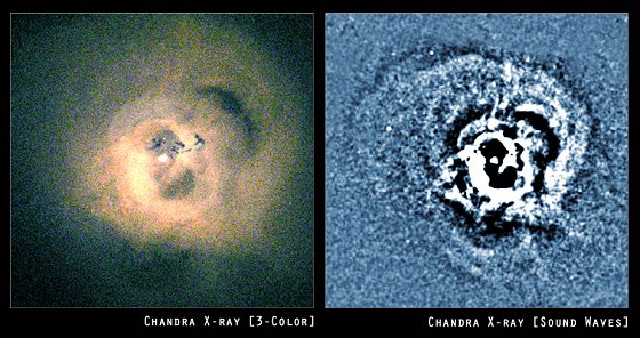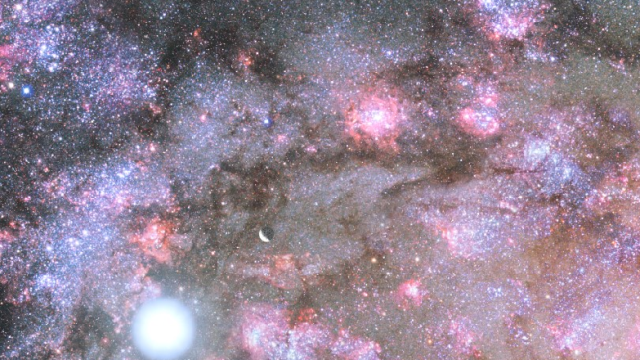You’ve heard it before: In space, no one can hear you scream. That’s because sound doesn’t move through a vacuum, and everyone knows that space is a vacuum. The thing is, that’s not completely true.
Space isn’t uniform nothingness. It’s full of stuff. In between the stars, there are clouds of gas and dust. These clouds are sometimes the remains of old stars that went out in a blaze of explosive glory, and they’re the regions where new stars form. And some of that interstellar gas is dense enough to carry sound waves, just not sound perceptible to humans.
Here’s How It Works
When an object moves — whether it’s a vibrating guitar string or an exploding firecracker — it pushes on the air molecules closest to it. Those displaced molecules bump into their neighbours, and then those displaced molecules bump into their neighbours. The motion travels through the air as a wave. When the wave reaches your ear, you perceive it as sound.
As a sound wave passes through the air, the air pressure in any given spot will oscillate up and down; picture the way water gets deeper and shallower as waves pass by. The time between those oscillations is called the sound’s frequency, and it’s measured in units called Hertz; one Hertz is one oscillation per second. The distance between “peaks” of high pressure is called the sound’s wavelength.

Image: Anatomy of a sound wave via Aarkentechnologies/Wikimedia Commons
Sound waves can only travel through a medium if the length of the wave is longer than the average distance between the particles. Physicists call this the “mean free path” — the average distance a molecule can travel after colliding with one molecule and before colliding with the next. So a denser medium can carry sounds with shorter wavelengths, and vice versa.
Sounds with longer wavelengths, of course, have lower frequencies, which we perceive as lower pitches. In any gas with a mean free path larger than 17m (the wavelength of sounds with a frequency of 20 Hz), the waves that propagate will be too low-frequency for us to hear them. These sound waves are called infrasound. If you were an alien with ears that could pick up this very low notes, you’d hear really interesting things in some parts of space.
The Song of a Black Hole

Ripples in interstellar gas, produced by sound waves from a supermassive black hole. Image credit: NASA
About 250 million light years away, at the center of a cluster of thousands of galaxies, a supermassive black hole is humming to itself in the deepest note the universe has ever heard (as far as we know). The note is a B-flat, about 57 octaves below middle C, which is about a million billion times deeper than the lowest frequency sound we can hear (yes, that’s an actual number from actual scientists).
The deepest sound you’ve ever heard has a cycle of about one oscillation every twentieth of a second. The drone of Perseus’ black hole has a cycle of about one oscillation every 10 million years. That’s sound on a massive scale, played across deep time.
We know this because in 2003, NASA’s Chandra X-ray space telescope spotted a pattern in the gas that fills the Perseus Cluster: concentric rings of light and dark, like ripples in a pond. Astrophysicists say those ripples are the traces of incredibly low frequency sound waves; the brighter rings are the peaks of waves, where there’s the greatest pressure on the gas. The darker rings are the troughs of the sound waves, where the pressure is lower.
Hot, magnetized gas rotates around the black hole, more or less like water swirling around a drain. All that magnetized material in motion generates a powerful electromagnetic field. The field is strong enough to accelerate material away from the brink of the black hole at nearly the speed of light, in huge bursts called relativistic jets. These relativistic jets force gas in their path out of the way, and that disturbance produces deep cosmic sound waves.
That deep intergalactic sound carried through the Perseus Cluster for hundreds of thousands of light years from its source, but sound can only travel as far as there’s enough gas to carry them, so Perseus’ infrasound drone stops at the edge of the gas cloud that fills its cluster of galaxies. That means we can’t detect the sound here on Earth; we can only see its effects on the gas cloud. It’s like we’re staring across space into a soundproofed chamber.
A Groaning Planet
Video credit: ESA
Closer to home, our planet makes a deep groan every time its crust shifts, and sometimes those low-frequency sounds carry all the way into space. During an earthquake, the ground’s shaking can produce vibrations in the atmosphere, usually with a frequency between one and five Hz. If the earthquake is strong enough, it can send infrasound waves up through the atmosphere to the edge of space.
Of course, there’s no clear line where Earth’s atmosphere stops and space begins. The air just gradually gets thinner until eventually there’s none. From about 80 to about 550km above the surface, the mean free path of a molecule is about a kilometer. That means the air at this altitude is about 59 times too thin for audible sound waves to travel through, but it can carry the longer waves of infrasound.
When a magnitude 9.0 earthquake shook the northeastern coast of Japan in March 2011, seismographs around the world recorded how its waves passed through the Earth, and the earth’s vibrations also set off low-frequency vibrations in the atmosphere. Those vibrations travelled all the way up to where the European Space Agency’s Gravity Field and Steady-State Ocean Circulation Explorer (GOCE) satellite maps Earth’s gravity from low orbit, 270km above the surface. And the satellite recorded those sound waves – sort of.
GOCE has very sensitive accelerometers on board, which control the ion engine that helps keep the satellite in a stable orbit. On 11 March 2011, GOCE’s accelerometers detected vertical displacement in the very thin atmosphere around the satellite, along with wavelike shifts in air pressure, as the sound waves from the earthquake passed by. The satellite’s thrusters corrected for the displacement and saved the data, which became an indirect recording of the earthquake’s infrasound.
The indirect recording was buried in the satellite’s thruster data until a team of researchers led by Raphael F. Garcia happened across it and published a paper on their findings.
The First Sound in the Universe
And if you could somehow travel back in time to the first 760,000 years after the Big Bang (we’ve already turned you into an alien who can hear in infrasound, so of course you can also travel through time, right?), you could have heard the sound of the universe growing.
Until about 760,000 years after the Big Bang, the matter in the universe was still densely packed enough that sound waves could travel through it — and they did.
Around this time, the first photons were also beginning to travel through the universe as light. Things had finally cooled enough after the Big Bang to allow subatomic particles to condense into atoms. Before that cooling happened, the universe was full of charged particles – protons and electrons – that either absorbed or scattered photons, the particles (sort of) that make up light. When the protons and neutrons started to form neutrally charged atoms, light was free to shine all over the place.
Today, that light reaches us as a faint glow of microwave radiation, visible only to very sensitive radio telescopes. Physicists call it the cosmic microwave background. It’s the oldest light in the universe, and it contains a recording of the oldest sound in the universe.
Remember that sound waves travel through the air (or interstellar gas) as oscillations in pressure. When you compress a gas, it gets hotter; on a large scale, that’s actually how stars form. And when a gas expands, it cools. The sound waves travelling though the early universe caused faint variations in pressure in the gaseous medium, which in turn left faint variations in temperature etched into the cosmic microwave background.
Using those temperature variations, University of Washington physicist John G. Cramer managed to reconstruct the sounds of the expanding universe. He had to multiply the frequency by a factor of 10^26 just to make it audible to human ears. (Listen to it here or in the video above.)
So it’s still true that no one can hear you screaming in space, but there are sound waves moving through the clouds of gas between the stars or in the rarefied wisps of Earth’s outer atmosphere.
